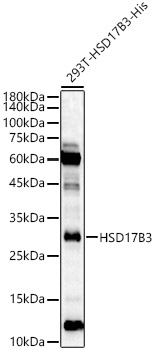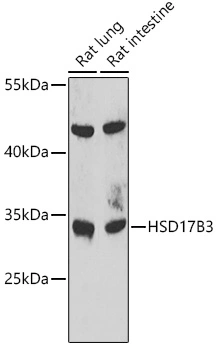HSD17B3 antibody
GTX114480
ApplicationsImmunoFluorescence, Western Blot, ImmunoCytoChemistry, ImmunoHistoChemistry, ImmunoHistoChemistry Paraffin
Product group Antibodies
TargetHSD17B3
Overview
- SupplierGeneTex
- Product NameHSD17B3 antibody
- Delivery Days Customer9
- Application Supplier NoteWB: 1:500-1:3000. ICC/IF: 1:100-1:1000. IHC-P: 1:100-1:1000. *Optimal dilutions/concentrations should be determined by the researcher.Not tested in other applications.
- ApplicationsImmunoFluorescence, Western Blot, ImmunoCytoChemistry, ImmunoHistoChemistry, ImmunoHistoChemistry Paraffin
- CertificationResearch Use Only
- ClonalityPolyclonal
- Concentration0.92 mg/ml
- ConjugateUnconjugated
- Gene ID3293
- Target nameHSD17B3
- Target descriptionhydroxysteroid 17-beta dehydrogenase 3
- Target synonyms17-beta-HSD 3; 17-beta-HSD3; 17-beta-hydroxysteroid dehydrogenase type 3; EDH17B3; estradiol 17-beta-dehydrogenase 2; hydroxysteroid dehydrogenase 3; SDR12C2; short chain dehydrogenase/reductase family 12C member 2; testicular 17-beta-hydroxysteroid dehydrogenase; testosterone 17-beta-dehydrogenase 3
- HostRabbit
- IsotypeIgG
- Protein IDP37058
- Protein NameTestosterone 17-beta-dehydrogenase 3
- Scientific DescriptionThis isoform of 17 beta-hydroxysteroid dehydrogenase is expressed predominantly in the testis and catalyzes the conversion of androstenedione to testosterone. It preferentially uses NADP as cofactor. Deficiency can result in male pseudohermaphroditism with gynecomastia. [provided by RefSeq]
- Storage Instruction-20°C or -80°C,2°C to 8°C
- UNSPSC12352203
References
- Estrogen synthesis in the stomach of Sprague-Dawley rats: comparison to Wistar rats. Kobayashi H et al., 2021 Feb 6, Exp AnimRead more
- Transplantation of encapsulated human Leydig-like cells: A novel option for the treatment of testosterone deficiency. Feng X et al., 2021 Jan 1, Mol Cell EndocrinolRead more
- Loss of exogenous androgen dependence by prostate tumor cells is associated with elevated glucuronidation potential. Zimmer BM et al., 2016 Aug, Horm CancerRead more






